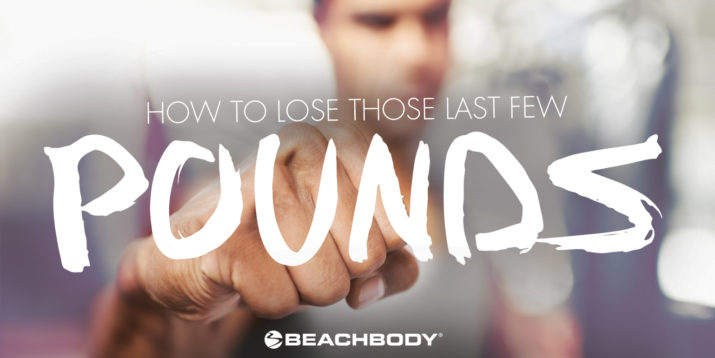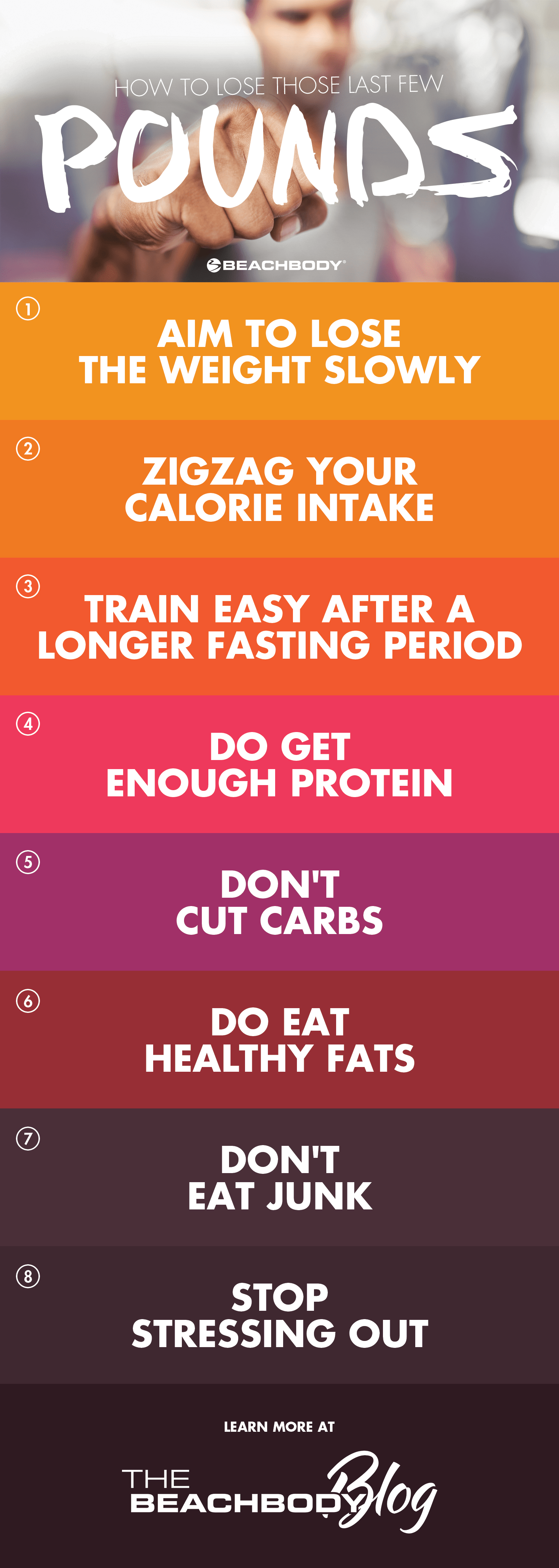How to Lose Those Last Few Pounds

“I have been working hard to be healthier and more fit, but I can’t seem to lose the little bit of belly fat that I have carried for years. I eat right, have done P90X, P90X2, INSANITY, and now P90X3 … but my one-pack is still there…Help!”—Jeff R.
The beginning and the end of your fitness program are the two most difficult times, with the latter being by far the most frustrating.
Losing those last few pounds, whether it’s off of your stomach, hips, thighs, shoulders, or triceps, can be brutally hard.
Let’s take a brief look at why, and then we’ll go into some strategies you can employ that will guarantee you’re ready for summer.
You Can’t Spot Reduce
First, you can’t “spot reduce” a trouble area.
Thanks largely to genetics, we all hang onto our last vestiges of body fat somewhere.
Usually, guys are stuck with the gut and the ladies get the hips — but the process to get rid of it remains the same for all of us: Reduce your overall body fat percentage and eventually, you’ll lose in those “problem areas.”
Focusing on them may develop the muscle there, but if you want to get rid of the fat on top of that muscle, the key is patience. It’ll happen, but it’ll take time.
This means all of your training (i.e., working out or exercising) should work the whole body, and you’re going to need to turn the screw a notch when it comes to diet.
Weight Loss 101
The beginning of a weight-loss program is pretty straightforward. If you eat less and exercise more, you tend to drop pounds at a fairly consistent clip.
Your body considers its fat stores to be emergency fuel sources. It doesn’t know you’re under-eating and working hard by choice; it thinks you’re in an emergency situation and responds accordingly.
But then something counterintuitive happens. Your body composition — the ratio of muscle to fat tissue — changes, further increasing your metabolism.
And yet, your weight loss slows. What’s up with that?
The reasons for this are sundry and intertwined, but the gist of it is that your body doesn’t know when the emergency situation will end, so it adapts hormonally to hold on to that emergency fat.
Furthermore, a little fat on your body is a good thing.
That six-pack you so eagerly seek simply isn’t part of a normal state of being for most body types, so your system is going to push back, making those last few pounds a challenge.
Don’t worry; you can still be healthy and have washboard abs.
It’s just that this counterintuitive situation requires a counterintuitive solution: You need to eat more, something that’s always hard for first-time dieters to adjust to.
This can happen long before you’re at your final stage of weight loss, but that’s irrelevant.
Once weight loss starts to slow, follow the steps below in order to keep the weight falling off and your six-pack chiseling into form.
Although you can certainly cherry-pick the solution you think will best work for you, I’d recommend starting at the top.
8 Steps to Lose Those Last Few Pounds
1. Lose weight slowly
You probably lost weight quickly when you began working out but you need to redesign your attack on the last hurrah.
By targeting a one- to two-pound-per-week loss, you can eat enough to fuel workout performance and recovery, which will keep your metabolism revving, which is the key to everything you’re after.
Shoot for a caloric deficit of 300–600 calories a day. If that’s not working for you, you might want to…
2. Zigzag your calories
Also called “refeeding” in bodybuilding lexicon, zigzagging means eating more calories on some days and less on others to determine the number of calories that works best for your goals.
For example, if you’ve been eating a low-calorie diet you can assume you need to add calories. To find out how many, try increasing by about 400-500 calories.
Eat that way four days per week while keeping calories where they are now on the other days.
Keep in mind that, as your fitness increases, so do your caloric needs, so if this stops working, it’s probably time to go up even more.
3. Train easy after a longer fasting period (i.e. when you wake up, before breakfast)
Adding some morning exercise on an empty stomach also improves fat mobilization and is a good way to burn some extra calories and not negatively affect your hard training session of the day.
When you’re looking to cut the last few pounds, this “trick” is effective, but be careful.
Too much exercise, especially when your diet is lean on calories, can make you catabolic (burning muscle as well as fat) and that’s something you probably don’t want.
The catabolic risk means that this is probably not a great tactic for those with figure and bodybuilding goals, and should be saved for those whose ultimate goal is weight off of the scale.
With this in mind, if you’re doing a harder workout upon waking up, it’s not a bad idea to grab a small carb snack before.
4. Get enough protein
Protein is made up of amino acids, the building blocks for many things in the body, including muscle.
Therefore, protein is vital for muscle building. And muscle building is vital for performance. And performance is vital for results.
How much protein depends on the individual, but Beachbody (now BODi) nutrition plans are designed to make sure you get plenty.
That said, it might not hurt to consider supplementing protein intake with a post-workout supplement like Beachbody Performance Recover (whey and plant-based).
5. Don’t cut out carbohydrates
Strategic use of carbohydrates for fuel is vital for performance, and performance is how you gauge how your diet is working.
While dramatically cutting down your carb consumption can be helpful in the initial stages of weight loss because your body isn’t fit enough to train very hard, it’s a huge mistake to cut carbs once you’re fit.
Carbs fuel both your muscles and your brain. They are also more muscle-sparing (slowing muscle breakdown) than either proteins or fats when you’re training, so you need them so that you don’t go catabolic.
That’s not an invitation to try the All-Bread, All-Day Diet, however, since many carbs, particularly bread, pasta, and other starches, as well as added sugar, can add up quickly calorically.
Shoot for somewhere in the 40 percent of your total calories, depending on your training, is best for this stage in your nutrition arsenal.
6. Don’t cut out fat
According to a review in the Journal of the International Society of Sports Nutrition, dietary fat intake is believed to impact anabolic hormone levels — and that includes testosterone, a known performance enhancer.
A safe range for dietary fat seems to be about 20 percent to 30 percent of your calories.
But keep in mind that fats have more than double the calories of proteins and carbs, so keeping them at this level means your diet should hyper-focus on the healthiest choices: fish, avocados, olives, nuts, and seeds.
7. Do cut out junk
Look, there’s just no simple way to get your body to weigh less than it naturally wants to, which is what you’re attempting when you go for a chiseled look, without some sacrifice — and by sacrifice, I mean the usual suspects like added sugars, fried foods, alcohol, soda, etc.
Notice I just cited the importance of every macronutrient food group. Junk foods have no importance, except (arguably) for pleasure.
8. Stop stressing about those last few pounds so much
If you follow all these steps, in all likelihood, you’ll nail your goals. But also keep in mind that those last few pounds probably don’t matter that much.
Human beings can be perfectly healthy and be a little soft around the edges. Sure, it’s pretty rewarding to get totally ripped or swimsuit competition-hot sometimes, but that should be temporary.
This advice isn’t intended to dissuade you from going for a six-pack. It’s just there to offer some perspective.
You don’t need to lose those last few pounds; you want to lose those last few pounds.
So don’t stress about it — because excess stress is the enemy of results. You’ll get there. Just be patient.
Once you get there, enjoy your moment and then relax a little.
Ultimately, making sure there are periods in each year when you eat more actually benefits your fitness. Athletes spend at least part of the year eating all they want (within reason), perhaps even more than they need, to ensure they have the reserves to train as hard as they can.
Fighting weight, race weight, or competition shape is a phase. Bodybuilders and fitness trainers don’t walk around in contest shape all the time. It’s not because they’re lazy.
Six-packs look awesome in photos and impress your friends at reunions, but your body functions better with a little more “reserve.”

Sources:
- Abe T, Kawakami Y, Sugita M, Fukunaga T. “Relationship between training frequency and subcutaneous and visceral fat in women.” Med Sci Sports Exerc 1997 Dec;29(12):1549-53
- American Journal of Clinical Nutrition, Dec 1996 v64 n6 p850(6) “Effects of dietary fat and fiber on plasma and urine androgens and estrogens in men: a controlled feeding study.” Joanne F. Dorgan; Joseph T. Judd; Christopher Longcope; Charles Brown; Arthur Schatzkin; Beverly A. Clevidence; William S. Campbell; Padmanabhan P. Nair; Charlene Franz; Lisa Kahle; Philip R. Taylor.
- Haff GG, Lehmkuhl MJ, McCoy LB, Stone MH. “Carbohydrate supplementation and resistance training” J Strength Cond Res 2003 Feb;17(1):187-96
- Hart et al. “Efficacy of a high-carbohydrate diet in catabolic illness.” Crit Care Med 2001 Jul;29(7):1318-24
- Nygren J, Nair KS. “Differential regulation of protein dynamics in splanchnic and skeletal muscle beds by insulin and amino acids in healthy human subjects.” Diabetes 2003 Jun;52(6):1377-85
- Rockwell MS, Rankin JW, Dixon H. “Effects of muscle glycogen on performance of repeated sprints and mechanisms of fatigue.” . Int J Sport Nutr Exerc Metab 2003 Mar;13(1):1-14
- The Journal of Nutrition, Sept 2000 v130 i9 p2356 “High Dietary Fat Intake Increases Renal Cyst Disease Progression in Han:SPRD-cy Rats. ” Shobana Jayapalan; M. Hossein Saboorian; Jeff W. Edmunds; Harold M. Aukema.
- Van Proeyen, Karen. Effects of training in the fasted state. “Medicine & Science in Sports & Exercise.” June 2010.
